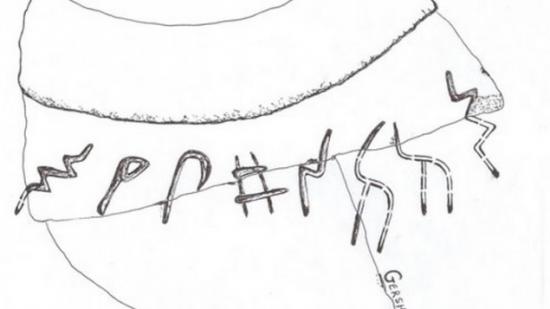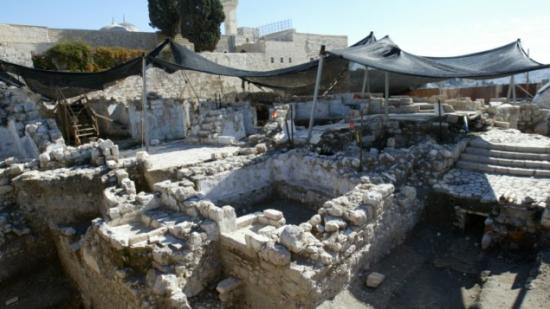Researcher says ancient inscription describes low quality of jug’s contents, served to King Solomon’s laborers and soldiers
Marissa Newman

The engraving found on a 3,000-year-old clay jug in Jerusalem (photo credit: courtesy)
An ancient eight-letter inscription — dating back to King Solomon’s reign in Jerusalem some 3,000 years ago — was deciphered by a researcher from the University of Haifa, shedding light on the Solomonic kingdom’s impressively sophisticated administrative system
The carving was discovered on a clay jug in the Ophel area, near the southern wall of the Temple Mount, by a Hebrew University archaeological team headed by Dr. Eilat Mazar. It is considered the most ancient Hebrew engraving to emerge from the archaeological digs in Jerusalem to date.
However, the meaning of the cryptic inscription eluded researchers until Professor Gershon Galil of the University of Haifa interpreted it as a classification of a type of wine stored in the jug. He published his findings in the journal “New Studies on Jerusalem.”
According to Galil, the first intact letter of the inscription was actually the last letter of a longer word that got cut off and represented the date. The middle portion refers to the type of wine in the jug, a cheap variety. The final letter was also cut off from a longer word, and according to Galil listed the location from which the wine was sent.

'The Meeting of King Solomon and the Queen of Sheba,' by Erasmus Quellinus, 17th century
Galil estimated that the carving was written in the middle of the tenth century BCE, after King Solomon built the First Temple, his palaces, and the surrounding walls that unified the three areas of the city — the Ophel area, the city of David, and the Temple Mount. These tremendous infrastructural projects contributed, Galil said, to the sudden need for copious quantities of poor-quality wine.
“This wine was not served on the table of King Solomon nor in the Temple,” Galil wrote. “Rather it was probably used by the many forced laborers in the building projects and the soldiers that guarded them. Food and drinks for these laborers were mainly held in the Ophel area.” His theory is shored up by pottery fragments found in Arad, Galil wrote.
Beyond that, Galil emphasized that the find lends support to claims of an organized bureaucratic system and provides evidence that writing was prevalent at the time.

Archaeological excavations in Jerusalem’s Old City next to the Temple Mount (photo credit: Olivier Fitoussi/Flash90)
“The ability to write and store the wine in a large vessel designated for this purpose, while noting the type of wine, the date it was received, and the place it was sent from, attests to the existence of an organized administration that collected taxes, recruited laborers, brought them to Jerusalem, and took care to give them food and water,” Galil said.
“Scribes that could write administrative texts could also write literary and historiographic texts, and this has very important implications for the study of the Bible and understanding the history of Israel in the biblical period.”